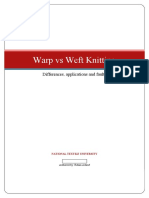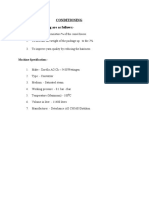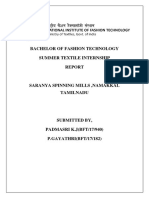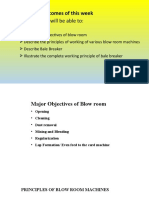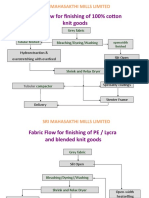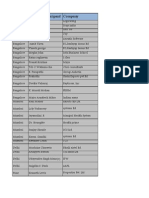Yarn Winding Methods
Yarn Winding Methods
Uploaded by
CNJSWAMICopyright:
Available Formats
Yarn Winding Methods
Yarn Winding Methods
Uploaded by
CNJSWAMIOriginal Description:
Original Title
Copyright
Available Formats
Share this document
Did you find this document useful?
Is this content inappropriate?
Copyright:
Available Formats
Yarn Winding Methods
Yarn Winding Methods
Uploaded by
CNJSWAMICopyright:
Available Formats
Dye package the quality pre-requisite for yarn dyeing Of the different processes for applying colour to textile
e products, yarn dyeing is a standard procedure boasting a number of advantages. The fact that it can be integrated into various textile process sequences and has hardly any limits with regard to yarn, emphasises the versatility of package dyeing. Economic factors often weigh heaviest. Package dyeing with its relatively small number of process stages, involves correspondingly low costs. Considering the speed of response to market demands, textile manufacturers benefit from the high flexibility of the process. The choice of dyeing technology is driven by the needs of market, which are: dyeing accuracy The dyed batch has to conform to the standard. response speed The importance of this requirement varies according to the field of application. dyeing consistency Has to be ensured within a package, within a batch and from one batch to the other. quality The dyed yarn package has to unwind well in downstream operations and waste has to be avoided. The following article examines the importance of choosing the most appropriate winding technology in order to achieve the highest quality while maintaining optimum cost efficiency. Economy of the yarn dyeing process
fig.1:
Distribution of costs in the yarn dyeing process
The total costs of yarn dyeing vary between 1.5 and 7 US$/kg, depending on yarn and package quality, dye stuff and colour. Darker colours are more expensive than lighter colours. These costs include man power, electricity, dye stuff and other additives, building and depreciation costs. Figure 1 shows that the share of the winding costs are only minor. They distribute between 5 and 10 % of the overall dyeing costs. On the other hand the dye package quality has an affect of up to 30 % on the dyeing costs: capacity of dyeing machine DIGICONE winding allows an increase of density of approx. 15 % compared to random winding. This gives a proportional increase of the dyeing equipment. consumption of dye stuff and additives
Klaus Meier
1/6
04.01.2007
A regularity of + 2.5 % of the density within the package and from package to package allows to work with lower amount of dye stuff and especially of additives improving the regularity of the dye distribution. dye stuff circulation A stable package build-up allows higher circulation of the dye stuff without generating channels. This increases the dye evenness and allows the reduction of the dyeing time. contact time with dye stuff A very even distribution of the density within the packages and from package to package reduces the necessary minimum contact time as the dye stuff can penetrate the package evenly. amount of re-dyes An optimum package performance supports a good dyeing quality, which reduces the amount of re-dyes.
Experiences in various dye houses have shown that the appropriate package formation had an influence on the overall dyeing costs which was up to 6 times higher than the winding costs. Taking into regard that the depreciation is only 30 % of the winding costs we have a pay back period for high tech winders like SSM machines of less than half a year in comparison to cheap technology. Requirements on a dye package According to the above mentioned influences on the dyeing process following requirements on the dye package can be listed: density The dye stuff penetrates the packages as a liquid. Areas with higher density will be by-passed. To compensate this effect the contact time of the dye stuff has to be increased to improve the evenness of the dyeing. The regularity within a package and from package to package has to be in a range of + 2.5 %. Ribbons where the density can increase about 50 to 100 % have to be avoided. In regard to the capacity of the dyeing equipment, the density should be as high as possible. outer diameter To get an optimum flow through the stack of dye packages the outer diameter has to be very accurate. Variations should be within + 0.5 mm. shape Cylindrical packages are the optimum packages for dyeing due to various reasons. With cylindrical packages an optimum packing of the dyeing vessel can be achieved. Additionally the cylindrical packages have an even flow resistant over the length of the axis which make it much easier to achieve an even distribution of the dye stuff. The sides of the packages have to be straight to ensure an optimum sealing between the packages to avoid by-passing of the dye stuff. pressing To increase the density often the dye packages are pressed. By pressing the packages the layers of yarn are moved relatively to each other. This leads to higher hairiness of the yarn and to very poor take-off behaviour. Better is to wind directly the desired density and to avoid the pressing at all. SSM DIGICONE technology allows 15 20 % higher density directly in the wound package without pressing. Influences on the package build-up Looking at the requirements on the dye packages it can be seen that the density is by far the most important property which has to be controlled through the whole package build-up as
Klaus Meier
2/6
04.01.2007
well as from package to package. The most important parameters for the density are following (fig. 2): crossing angle With increasing crossing angle the density becomes lower. The reason for that lies in the fact that the number of thread crossings increases. distance between threads of a layer With smaller distances between the neighboured yarns of a layer the yarn can be stored more compact in the package. The density increases. thread tension during winding With an increasing thread tension during winding the density becomes higher. This effect depends very much on the yarn properties. As more elasticity the yarn has as higher is the influence of the thread tension. back pressure on package during winding Also with higher pressure of the package against the pressure roll the density can be increased. This only works with yarns having a high volume and thus can be compressed.
fig. 2: Influences on the package density The first two parameters are only geometric parameters which are not only influenced by the basic setting of the machine but also by the type of winding which has been chosen. Crossing angle and distance between the threads of a layer are strictly connected to each other by a function of the diameter. So depending on the type of winding only one parameter can be kept constant over a package travel. Fig. 3 shows the different types of winding: random winding Random winding works with a constant crossing angle over the whole package. This is realised by a constant winding speed and a constant traverse speed. Usually this is the type of winding of friction driven winders. The main problem with this type of winding is, that at certain diameters the ratio between the double strokes and the circumference is a whole number thus leading to one thread layer directly on or beside the next one, the so-called ribbons or patterns. In this area the density of the package can increase by 100 %. Ribbon breaking devices reduce this effect but spread it over a bigger area. This strong increase of the density appears only in a very small area but generates problems during dyeing as the dye stuff also has to penetrate fully these areas. precision winding In precision winding the number of revolutions of the package and the traverse work with a constant ratio. This is realised with winders having a direct drive for the package. The advantage of the precision winding is that the distance between the
Klaus Meier
3/6
04.01.2007
threads is constant over the whole package. Therefore the crossing angle decreases with increasing diameter. The density on the outside is higher than on the inside. Thus the stability of the package is relative low. These packages have to be handled with care otherwise the outer layers tend to fall off. DIGICONE winding To combine the advantages of a random wound package with those of a precision wound package Schweiter invented in the 1970s the DIGICONE winding. With this winding the ratio between double strokes and number of revolutions is kept constant . for a certain diameter range. The crossing angle varies only in a range of + 1 With this type of winding it is possible to avoid any areas of patterns with the extreme increase of the density. Also the density does not change over the package diameter. The package stays in stable structure.
fig. 3: Types of winding Ribbon areas in packages doe not only disturb the dyeing process due to the tremendously higher density but they also generate problems in the downstream processes. As the threads lie parallel without crossing points or only 1 or 2 crossing points they tend to catch the neighboured thread during take-off. This leads to tension peaks as shown in fig. 4. To avoid thread breaks in this case, the unwinding speed has to be reduced by several hundreds meter per minute.
fig. 4: Thread tension during unwinding
Klaus Meier
4/6
04.01.2007
One of the most important parameters for the density is the winding tension. With most of the existing winding equipment only a limited or even no control of the winding tension is possible. During the winding this leads to varying density in dyeing packages or not uniform bobbins for end-use. The most common kinds of thread tension variations coming from the feeder package are: variations due to the diameter of the feeder package variations due to the traverse of the feeder package tension peaks due to clamped layers of the feeder package SSM has developed the new digitensTM (fig. 5) to provide the customer the full control over the winding tension independent of the quality of the supply material or the chosen winding speed. The active working digitensTM system does not only allow to monitor the winding tension and give an controlled increase to the winding tension but also allows to reduce the tension thus leading to higher production speeds and efficiency of the equipment.
fig. 5: Influence of digtensTM on the thread tension Choice of the optimum package
fig. 6: Which package is the best? For an optimum use of the dyeing equipment nowadays the cylindrical shape is state-of-theart. Compared to conical packages the use of the space is more than 10 % higher. Comparing the density without pressing between DIGICONE winding and random winding Klaus Meier 5/6 04.01.2007
another 15 % can be gained. As the take-off behaviour of the DIGICONE winding is much better, the conical shape is not necessary at all. The advantages of DIGICONE winding for the dyeing process can be summarised as follows: Higher density gives a higher capacity to the dyeing equipment without any pressing. Additionally as more yarn can be packed on the packages the knot free length is 15 % higher and less packages have to be handled per lot. The density is very even within the package so that shorter dyeing cycles are possible. Less additives are required and the dyeing quality improves. The absence of ribbon areas ensures higher re-winding speeds are can even make the re-winding process unnecessary. Choice of the equipment Traditionally the focus of the technological competence of SSM lies in the area of winding technologies. The efficiency of each production step where yarn is processed depends strongly on the quality of the supply bobbin. To achieve a top performance it is very important to know the requirements of the downstream processes to optimise the build-up of the bobbin accordingly. The result is a variety of bobbin formats and machines for their production. All these machines have in common SSMs philosophy that the machine is a tool enabling the customer to produce valuable products. The machines are striking due to their ergonomic and attractive design. But they also ensure first class efficiency and flexibility, based on the unique preciflexTM technology and the concept of the individual single position drives. The market as well as every single customer are in the centre of all activities of SSM. The Supply of hardware and software nowadays is not sufficient to benefit of the full potential of the machines. Technology centres and test rooms in Europe and in Asia, supported by a global network of local service stations, ensure an optimum productivity of the machines over a long term period.
fig. 7: SSM TW2-W preciflexTM precision package winder for dye packages and re-winding
Klaus Meier
6/6
04.01.2007
You might also like
- Modern Cotton Spinning Machinery, Its Principles and ConstructionFrom EverandModern Cotton Spinning Machinery, Its Principles and ConstructionNo ratings yet
- Global Warming. PPT - For KidsDocument58 pagesGlobal Warming. PPT - For KidsCNJSWAMI80% (5)
- 2002-2004 fsc600 SilverwingDocument160 pages2002-2004 fsc600 SilverwingDavid BenitoNo ratings yet
- Working On The YardDocument4 pagesWorking On The Yardapi-309277697No ratings yet
- Mathematical Approach For The Yarn Pressure in Bobbin Winding PDFDocument4 pagesMathematical Approach For The Yarn Pressure in Bobbin Winding PDFEduardoNo ratings yet
- 5-6 Winding Part 2Document28 pages5-6 Winding Part 2Md. Towfiq ImrozNo ratings yet
- 32 WindingDocument12 pages32 WindingVenkat PrasannaNo ratings yet
- Coolmax BlendsDocument2 pagesCoolmax BlendsErik Valentin BergströmNo ratings yet
- Yarn Winding: by M. Naveed AkhtarDocument29 pagesYarn Winding: by M. Naveed Akhtarfatimasajjad354100% (1)
- Flow Chart of Rieter Blow Room and Trutzschler Blow Room - Textile Education TipsDocument1 pageFlow Chart of Rieter Blow Room and Trutzschler Blow Room - Textile Education TipsVishnuMali100% (1)
- Fabric Manufacturing I-UnlockedDocument30 pagesFabric Manufacturing I-UnlockedDheerajNo ratings yet
- Optimization of Doubling at Draw Frame FDocument6 pagesOptimization of Doubling at Draw Frame FHamid MovahedNo ratings yet
- Welcome To Our PresentationDocument40 pagesWelcome To Our PresentationAbdul AzizNo ratings yet
- Yarn Manufacturing Tandem CardingDocument5 pagesYarn Manufacturing Tandem CardingIndrajit BoseNo ratings yet
- Concept of High Volume Instrument (HVI) HVI Used in Bale MDocument15 pagesConcept of High Volume Instrument (HVI) HVI Used in Bale MS.m. MahasinNo ratings yet
- 23 Ring 3Document9 pages23 Ring 3jdjprabhuNo ratings yet
- Airjet PracDocument12 pagesAirjet PracJunaid SuhailNo ratings yet
- Picking in Projectile LoomDocument2 pagesPicking in Projectile LoomAniket Khot100% (2)
- Lab Report 11Document8 pagesLab Report 11Umer GillNo ratings yet
- 3,4. Slub YarnDocument2 pages3,4. Slub Yarnshahadat hossainNo ratings yet
- 10 - 12 Fancy Yarn-1Document4 pages10 - 12 Fancy Yarn-1shahadat hossainNo ratings yet
- Murata SYL (Sharing Your Life)Document9 pagesMurata SYL (Sharing Your Life)Asyraaf YapNo ratings yet
- Fancy Yarns For FashionDocument7 pagesFancy Yarns For FashionharemboraNo ratings yet
- Uster Technologies Regularly Publishes Standards Such As USTERDocument12 pagesUster Technologies Regularly Publishes Standards Such As USTERHeba AlaaNo ratings yet
- Winding SectionDocument18 pagesWinding Sectionabhishek tripathiNo ratings yet
- Quality of Yarn ControlDocument12 pagesQuality of Yarn Controlsabbir2029_310230403No ratings yet
- 02 Winding PDFDocument41 pages02 Winding PDFDAWOOD MALIKNo ratings yet
- Carding TheoriesDocument2 pagesCarding TheoriesVaibhav K Dhange50% (2)
- Yarn PreparationDocument11 pagesYarn PreparationMohammad Hosain Reza Tushar100% (1)
- Yarn Preparation For WeavingDocument5 pagesYarn Preparation For WeavingSenthilNo ratings yet
- Textile Testing Presentation On Uster Tansorapid by Pritpal SinghDocument13 pagesTextile Testing Presentation On Uster Tansorapid by Pritpal SinghPritpalSingh0% (1)
- Warp Vs Weft KnittingDocument5 pagesWarp Vs Weft KnittingLinh NguyenNo ratings yet
- Assignment of YarnDocument21 pagesAssignment of YarnFaysal Islam75% (4)
- Fabric TestingDocument24 pagesFabric Testingjob wabwire100% (1)
- Spinning Maths-1Document12 pagesSpinning Maths-1tsukuyomi03No ratings yet
- Weaving and Weaving PreparationDocument20 pagesWeaving and Weaving PreparationGhandi AhmadNo ratings yet
- Application Report Measures To Yonquer PDFDocument12 pagesApplication Report Measures To Yonquer PDFMukarram Ali KhanNo ratings yet
- Study On Multiphase Weaving Machine.Document11 pagesStudy On Multiphase Weaving Machine.Naimul Hasan100% (1)
- Objects of Conditioning Are As FollowsDocument7 pagesObjects of Conditioning Are As FollowssachinnmimsNo ratings yet
- Cost Analysis: Quality Comes First, Rest Are ConsequencesDocument5 pagesCost Analysis: Quality Comes First, Rest Are ConsequencesAl AminNo ratings yet
- Rapier MotionDocument9 pagesRapier MotionuxmaNo ratings yet
- A Operator's Manual Beam Creel BC - ADocument23 pagesA Operator's Manual Beam Creel BC - AvikiNo ratings yet
- Warp Knitting:: Basic Warp Knit StructureDocument21 pagesWarp Knitting:: Basic Warp Knit Structuremike workuNo ratings yet
- Melange: The New Innovation in Textile With Melange: Case StudyDocument8 pagesMelange: The New Innovation in Textile With Melange: Case StudyFalgon IslamNo ratings yet
- YMIISpeed FrameDocument28 pagesYMIISpeed FrameAktarAliHossainNo ratings yet
- Card ClothingDocument9 pagesCard ClothingParesh HadkarNo ratings yet
- Textile Technology:: "Spinning": Rings and TravellersDocument10 pagesTextile Technology:: "Spinning": Rings and TravellersKuldeep SinghNo ratings yet
- Mixing:: Basic Tasks of Blow RoomDocument9 pagesMixing:: Basic Tasks of Blow RoommohitNo ratings yet
- Blow-Room (Autosaved)Document85 pagesBlow-Room (Autosaved)fekade100% (1)
- Main Textile Jury ReportDocument61 pagesMain Textile Jury ReportPadmasri JeyakumarNo ratings yet
- SizingDocument39 pagesSizingToa 97No ratings yet
- Fabric IV PPT MahasinDocument12 pagesFabric IV PPT MahasinS.m. MahasinNo ratings yet
- Assignment On Textured YarnsDocument13 pagesAssignment On Textured Yarnsdelwar100% (1)
- Comfort PropertiesDocument76 pagesComfort PropertiesSamyukthaNo ratings yet
- Weaving Technology 3rd Sem Unit - II DHTTDocument59 pagesWeaving Technology 3rd Sem Unit - II DHTTSANJIT JANANo ratings yet
- Rafi AssignmentDocument20 pagesRafi AssignmentsatexNo ratings yet
- Fibrograph Method PDFDocument4 pagesFibrograph Method PDFMd Amir Hossain100% (1)
- Chut Feed System ProcessDocument7 pagesChut Feed System ProcessShivam babyNo ratings yet
- Practical Observation of Material Flow On Ring-Fame, Auto Cone Rotor SpinningDocument5 pagesPractical Observation of Material Flow On Ring-Fame, Auto Cone Rotor SpinningTalha saeedNo ratings yet
- Spin Plan Bengal ThesisDocument149 pagesSpin Plan Bengal Thesisstylish eagleNo ratings yet
- Process Control in WeavingDocument14 pagesProcess Control in WeavingmetinNo ratings yet
- Learning Outcomes of This Week: The Students Will Be Able ToDocument24 pagesLearning Outcomes of This Week: The Students Will Be Able ToTalha saeedNo ratings yet
- Water and Wastewater Treatment PlanDocument2 pagesWater and Wastewater Treatment PlanCNJSWAMINo ratings yet
- MANUAL For Tanned LeatherDocument103 pagesMANUAL For Tanned LeatherCNJSWAMI100% (1)
- Tharaiyil Irangum Vimanangal Indumathi PDFDocument89 pagesTharaiyil Irangum Vimanangal Indumathi PDFCNJSWAMI100% (1)
- Double Black BrochureDocument2 pagesDouble Black BrochureCNJSWAMINo ratings yet
- Micro EncapsulationDocument5 pagesMicro EncapsulationCNJSWAMINo ratings yet
- Process Control and Safety in Chemical Processing PDFDocument44 pagesProcess Control and Safety in Chemical Processing PDFvinayakasisNo ratings yet
- Aegis FlyerDocument1 pageAegis FlyerCNJSWAMINo ratings yet
- Man Made FibersDocument44 pagesMan Made FibersdaviseleeNo ratings yet
- INdian Language Alphabets Gujarathi, Punjabi, Bengali and HindiDocument6 pagesINdian Language Alphabets Gujarathi, Punjabi, Bengali and HindiCNJSWAMINo ratings yet
- Fabric Flow For Finishing of 100% CottonDocument5 pagesFabric Flow For Finishing of 100% CottonCNJSWAMINo ratings yet
- How To Apply Perfume and After Shave: Our Noses Are Better Receptors Than You ThoughtDocument5 pagesHow To Apply Perfume and After Shave: Our Noses Are Better Receptors Than You ThoughtCNJSWAMINo ratings yet
- Atlantis Also Offers Wicking Undergarments Made of QuickDryDocument4 pagesAtlantis Also Offers Wicking Undergarments Made of QuickDryCNJSWAMINo ratings yet
- Cocoa ProcessingDocument3 pagesCocoa ProcessingCNJSWAMI100% (1)
- Unit I - Introduction To Technical WritingDocument10 pagesUnit I - Introduction To Technical WritingjoshuaNo ratings yet
- Classpoint For BeginnersDocument2 pagesClasspoint For BeginnersShane Lyn75% (4)
- Test 2Document6 pagesTest 2ochilovravshan57No ratings yet
- NTSE Haryana 2019 20 MAT C Question PaperDocument49 pagesNTSE Haryana 2019 20 MAT C Question PaperKeshav YadavNo ratings yet
- Netiquette 1Document2 pagesNetiquette 1josemanuelambito16No ratings yet
- Bashundhara 2Document3 pagesBashundhara 2Rajnarayan KarmakerNo ratings yet
- Research PaperDocument5 pagesResearch Paper2692rimmiNo ratings yet
- 2024 5.2 S3 Salt Assignment StudentDocument4 pages2024 5.2 S3 Salt Assignment StudentmartinfunjwNo ratings yet
- Week 16 Helm OrdersDocument13 pagesWeek 16 Helm OrdersRoger TerminatorNo ratings yet
- MSC Education (Psychology of Education) and MSC Psychology of Education (BPS) - Pre-Reading 2017Document3 pagesMSC Education (Psychology of Education) and MSC Psychology of Education (BPS) - Pre-Reading 2017Li MrNo ratings yet
- CHALLENGESDocument6 pagesCHALLENGESChelo IlagNo ratings yet
- MGQ301 Su22s3 SyllabusDocument6 pagesMGQ301 Su22s3 SyllabustonynoppsNo ratings yet
- MCQ Questions For Class 7 Science Chapter 4 Heat W+Document9 pagesMCQ Questions For Class 7 Science Chapter 4 Heat W+guruvisnu sureshNo ratings yet
- Chapter 12 Managing Marketing Communications - WEEK 7Document21 pagesChapter 12 Managing Marketing Communications - WEEK 7abe onimushaNo ratings yet
- Specialized Crime With Legal MedicineDocument271 pagesSpecialized Crime With Legal MedicineJasper Sinlao100% (2)
- TutLec 33Document21 pagesTutLec 33Anvesh KadimiNo ratings yet
- NGO Constitution Act ModelDocument6 pagesNGO Constitution Act ModelScribdTranslationsNo ratings yet
- HerzbergDocument11 pagesHerzbergSREENo ratings yet
- Cortex™ M3Document384 pagesCortex™ M313579krmyNo ratings yet
- CPCD 1Document20 pagesCPCD 1Sania SareenNo ratings yet
- The Paradox of Love - The Paradox of Love (Pascal Bruckner, Steven Randall, Richard Golsan) (Z-Library)Document9 pagesThe Paradox of Love - The Paradox of Love (Pascal Bruckner, Steven Randall, Richard Golsan) (Z-Library)Miguel PalauNo ratings yet
- Batu Kawan BHD Swot Analysis BacDocument13 pagesBatu Kawan BHD Swot Analysis BaclingamrubhiniNo ratings yet
- Nioec SP 47 28Document7 pagesNioec SP 47 28Shahram GhassemiNo ratings yet
- Janitza Manual UMG512 enDocument124 pagesJanitza Manual UMG512 enKullamas UdoNo ratings yet
- Bing Cheat Sheet For Sourcing ResumesDocument7 pagesBing Cheat Sheet For Sourcing ResumesjimstroudNo ratings yet
- Declaration & AcknowledgementDocument2 pagesDeclaration & AcknowledgementStarNo ratings yet
- 11 ANOVA (Student Version)Document30 pages11 ANOVA (Student Version)Li AlexNo ratings yet































